中职英语基础模块(上)unit1第一课时
外研版中职国规英语教材基础模块第一册第1单元
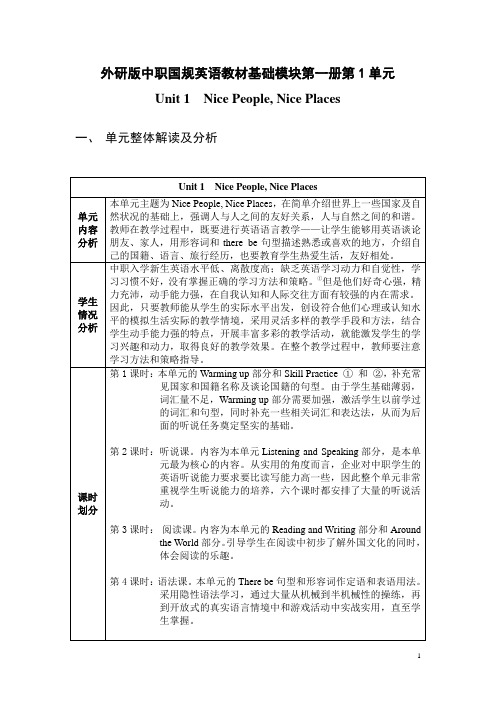
外研版中职国规英语教材基础模块第一册第1单元Unit 1 Nice People, Nice Places一、单元整体解读及分析Unit 1 Nice People, Nice Places单元内容分析本单元主题为Nice People, Nice Places,在简单介绍世界上一些国家及自然状况的基础上,强调人与人之间的友好关系,人与自然之间的和谐。
教师在教学过程中,既要进行英语语言教学——让学生能够用英语谈论朋友、家人,用形容词和there be句型描述熟悉或喜欢的地方,介绍自己的国籍、语言、旅行经历,也要教育学生热爱生活,友好相处。
学生情况分析中职入学新生英语水平低、离散度高;缺乏英语学习动力和自觉性,学习习惯不好,没有掌握正确的学习方法和策略。
①但是他们好奇心强,精力充沛,动手能力强,在自我认知和人际交往方面有较强的内在需求。
因此,只要教师能从学生的实际水平出发,创设符合他们心理或认知水平的模拟生活实际的教学情境,采用灵活多样的教学手段和方法,结合学生动手能力强的特点,开展丰富多彩的教学活动,就能激发学生的学习兴趣和动力,取得良好的教学效果。
在整个教学过程中,教师要注意学习方法和策略指导。
课时划分第1课时:本单元的Warming up部分和Skill Practice ①和②,补充常见国家和国籍名称及谈论国籍的句型。
由于学生基础薄弱,词汇量不足,Warming up部分需要加强,激活学生以前学过的词汇和句型,同时补充一些相关词汇和表达法,从而为后面的听说任务奠定坚实的基础。
第2课时:听说课。
内容为本单元Listening and Speaking部分,是本单元最为核心的内容。
从实用的角度而言,企业对中职学生的英语听说能力要求要比读写能力高一些,因此整个单元非常重视学生听说能力的培养,六个课时都安排了大量的听说活动。
第3课时:阅读课。
内容为本单元的Reading and Writing部分和Around the World部分。
中职高教版英语1基础模块

a personal name cardanddescribetheoccupationof others.
教学内容题 目
职业岗位知识点、能力点
与基本职业素质点
目标水平
识记
理解
熟练操作
应用
分析
Readingand Writing
知识点:Masterthegrammar structure Verb“be”pronouns.
【主要教学内容】
Content:
the words about name card and vocation.eg:telephone number; age; address; e-mail address; job (engineer; manager; secretary; teacher; student; doctor; nurse; singer; fans); position(boss)
2)about greeting:Good to meet you.
3)about personal information:What’s you name Where are you from Which company are you from
designpersonalname card.
【主要能力点与知识点应达到的目标水平】
the meaning of“last name”and“first name”.
9. Read and underline. Practice the dialogue with your partner and underline the sentences aboutasking one’s personal information.
职高英语基础模块1 高等教育 unit1 教案 第一课时
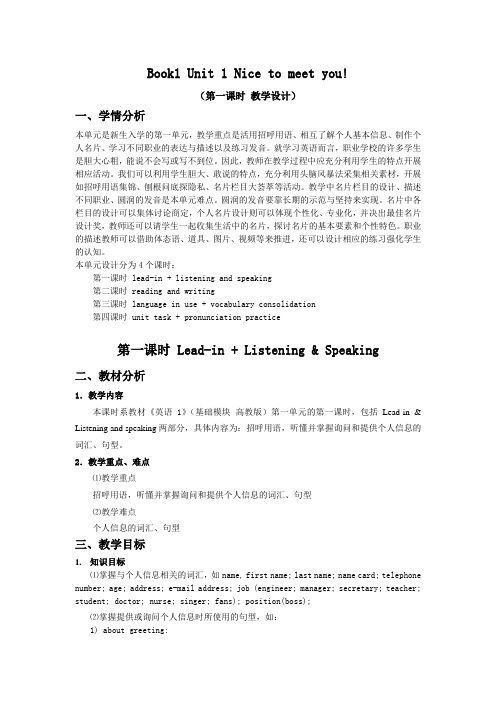
Book1 Unit 1 Nice to meet you!(第一课时教学设计)一、学情分析本单元是新生入学的第一单元,教学重点是活用招呼用语、相互了解个人基本信息、制作个人名片、学习不同职业的表达与描述以及练习发音。
就学习英语而言,职业学校的许多学生是胆大心粗,能说不会写或写不到位。
因此,教师在教学过程中应充分利用学生的特点开展相应活动。
我们可以利用学生胆大、敢说的特点,充分利用头脑风暴法采集相关素材,开展如招呼用语集锦、刨根问底探隐私、名片栏目大荟萃等活动。
教学中名片栏目的设计、描述不同职业、圆润的发音是本单元难点。
圆润的发音要靠长期的示范与坚持来实现。
名片中各栏目的设计可以集体讨论商定,个人名片设计则可以体现个性化、专业化,并决出最佳名片设计奖,教师还可以请学生一起收集生活中的名片,探讨名片的基本要素和个性特色。
职业的描述教师可以借助体态语、道具、图片、视频等来推进,还可以设计相应的练习强化学生的认知。
本单元设计分为4个课时:第一课时 lead-in + listening and speaking第二课时 reading and writing第三课时 language in use + vocabulary consolidation第四课时 unit task + pronunciation practice第一课时 Lead-in + Listening & Speaking二、教材分析1.教学内容本课时系教材《英语1》(基础模块高教版)第一单元的第一课时,包括Lead-in & Listening and speaking两部分,具体内容为:招呼用语,听懂并掌握询问和提供个人信息的词汇、句型。
2.教学重点、难点⑴教学重点招呼用语,听懂并掌握询问和提供个人信息的词汇、句型⑵教学难点个人信息的词汇、句型三、教学目标1.知识目标⑴掌握与个人信息相关的词汇,如name, first name; last name; name card; telephone number; age; address; e-mail address; job (engineer; manager; secretary; teacher; student; doctor; nurse; singer; fans); position(boss);⑵掌握提供或询问个人信息时所使用的句型,如:1) about greeting:Good morning.Hi.Nice to meet you.2) about personal informationWhat’s you name?Where are you from?Which company are you from?2.能力目标⑴学生能听懂关于询问和提供个人信息的对话。
中职英语基础模块上册unit1PPT课件

I'm fine,too.Tha
nk you! 我也是,谢谢
LOREM IPSUM DOLOR
Nice to meet you! 很高兴见到你 Nice to meet you,too! 也很高兴见到你
• Notes:
•
• 1. Introductions are important because a proper introduction will leave a good first impression upon others.
Between Acquaintances [ə´kweıntəns ]
Hello. Hi. How are you? How are you doing? How’s it going? What’s up? What’s new? Hi, there
How are you?
• Good, pretty good, great, fantastic, perfect • Not bad • So so • Not good • Bad, I am not in a good mood • I am in a blue mood • Terrible, awful
❖meet
❖ v.遇见;汇合;迎接
❖look
❖ v.看;瞧;看起来,显得
look at
看
❖class
❖ n.班级;课节
❖a lot of ❖ 许多+可数名词
例句:这有许多花。 eg. There are a lot of flowers.
❖read
❖ v.读;阅读
reading room 阅览室
例子:读书
nisi ut aliquip ex ea commodo consequat.
中职英语 基础模块1 Unit 1 Personal and Family Life

重点详解
1. family name given name Liu Xingting is a flight attendant.
Xinting is her given name. Xu Ming is a firefighter. Xu is his family name.
单词卡片 middle school student
younger sister
twin sisters especially
community
n.初中生 n.妹妹
n.孪生姐妹 adv.尤其是
n.社区
单词卡片 cook
Chongyang Festival handmade
family name delivery person
我的一名消防员,我的妻子是一名教师。
(2)He wants to work as a teacher in Western China. 他想在中国西部当一名教师。
重点详解
4.manage.v动词 manager.n 名词
英译汉: 1.He manages a department. 2.He is a manager.
n.厨师 重阳节 adj.手工的 n.姓 n.送货员
单词卡片 given name flight attendent firefighter vocational ancestor
n.名 n.空乘人员 n. 消防员 adj.职业的
n.祖先
单词卡片 address formal
situation
as for name after
little
三、选择题。
中职英语 基础模块1 Unit 1 Personal and Family Life
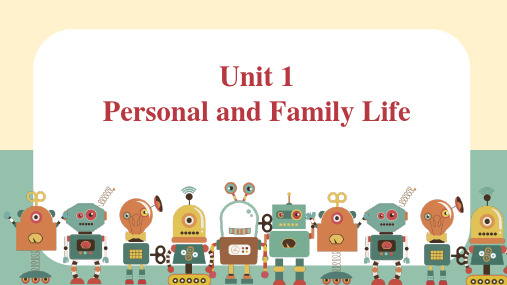
work as a teacher in Star Vocational(职
业的) High School.
记一记:记记交际语
交际语: Hello!My name is ...... . I'm...... . 你好!我的名字是.... 我是...(职业) Hi! My name is ...... . My family name is..... . 你好!我叫....。我姓.....。 Nice to meet you! My first name is... 很高兴见到你!我的名字是....。 Good morning/afternoon/evening! 早安!/午安! / 晚安! How do you do! 你好! I work as.... 我的工作是....
Smith Brown Brown
given name
first name (名字)
family name
last name (姓)
中国是姓在前名在后 西方是名在前姓在后
找一找:找出打招呼的英文表达
1. Hello! my name is Li Ting. I'm a
doctor. my family name is Li.
Words game
点击每个礼物,说出相应单词和释义
doctor
firefighter
delivery person
flight attendant
teacher
1. think and match. 将以下自我介绍与图中人物相匹配
52 3 4 1
1. Hello! my name is Li Ting. I'm a doctor. my family name is Li. 2. Hi! My name is Zhang Yifan. I'm a delivery person. Yi fan is my given name. 3. Nice to meet you! I'm Liu xinting. I'm a flight attendant. How can I help you? 4. Good morning!I'm Xu Ming, a firefighter. My given name is Ming means brightness. 5. Good afternoon! I'm Yu xinling. I work as a teacher in Star Vocational High School.
外研社中职英语基础模块(修订版)第一册Unit1第1课时
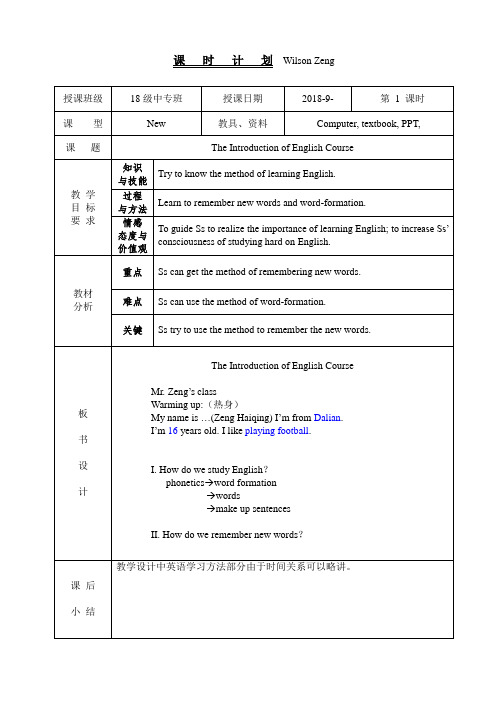
计
TheIntroduction ofEnglishCourse
Mr. Zeng’s class
Warming up:(热身)
My name is…(Zeng Haiqing) I’m fromDalian.
I’m16years old. I likeplaying football.
I.How do we study English?
New teaching.
1、How do we study English?
phoneticsword formation
words
make up sentences
Reading
Speaking instruction of studying English
Listening
Writing
2、How do we remember new words?
5、Introduction of the course & textbook.
课程介绍PPT
1) What to learn.
2) How to learn.
3) The requirements of English class.
1)Clear the learning aim.
2)Speak loudly and bravely.
e.g. Please drive carefully.
②合成法
handbag, homework,something, football,
basketball, housework
③转化法
hand n.手v.上交
empty adj.空的v.倒空
water n.水v.浇水
高教中职版《英语1(基础模块)》PPT多媒体课件unit01

B: No, I’m a manager.
Language in use
1 Grammar focus 2 Vocabulary practice
Grammar focus
I am = I’m you are = you’re
he is = he’s she is = she’s
Sara:
I’m from the US.
Activity 10
Listen and repeat. 跟读对话,学说选出的语句。
SLai rXai:aonianG: Looi dXimaornniainng.! I’m Sara Smith.
LSiaXraia:onian: GIosoydomurolransintgn, aMmises XSaiarao!nian?
Activity 9
Li Xiaonian: Li Xiaonian.
Sara:
Is your last name Xiaonian?
Li Xiaonian: No, my last name is Li.
Sara:
I see. Where are you from?
Li Xiaonian: I’m from Tianjin. Where are you from?
My name’s … / I’m … My first name / last name is … I’m from …
First Name
Last Name
From
Everyday English
Reading and writing
1
Activity 13
中职英语基础模块(上)unit1第一课时
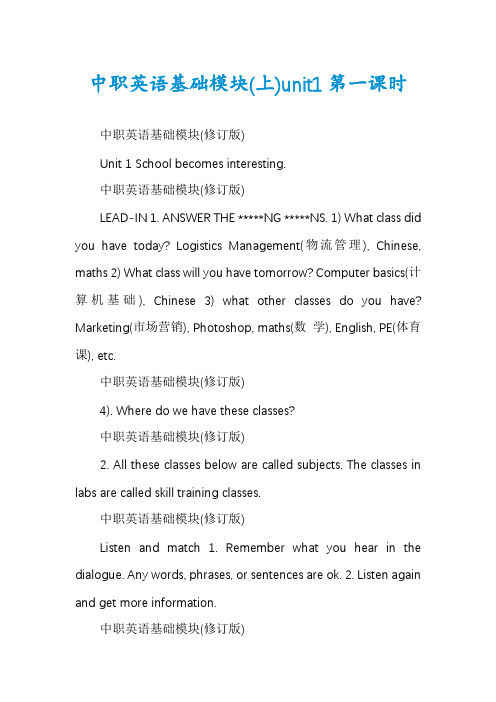
中职英语基础模块(上)unit1第一课时中职英语基础模块(修订版)Unit 1 School becomes interesting.中职英语基础模块(修订版)LEAD-IN 1. ANSWER THE *****NG *****NS. 1) What class did you have today? Logistics Management(物流管理), Chinese, maths 2) What class will you have tomorrow? Computer basics(计算机基础), Chinese 3) what other classes do you have? Marketing(市场营销), Photoshop, maths(数学), English, PE(体育课), etc.中职英语基础模块(修订版)4). Where do we have these classes?中职英语基础模块(修订版)2. All these classes below are called subjects. The classes in labs are called skill training classes.中职英语基础模块(修订版)Listen and match 1. Remember what you hear in the dialogue. Any words, phrases, or sentences are ok. 2. Listen again and get more information.中职英语基础模块(修订版)3. Discuss with your group members and fill in the blanks with your own words. Then show the dialogue to the class.中职英语基础模块(修订版)Listening and Speaking3Listen again and practice.再听录音,根据提示表演对话。
高教版中职英语基础模块第1册Unit1Nicetomeetyou!
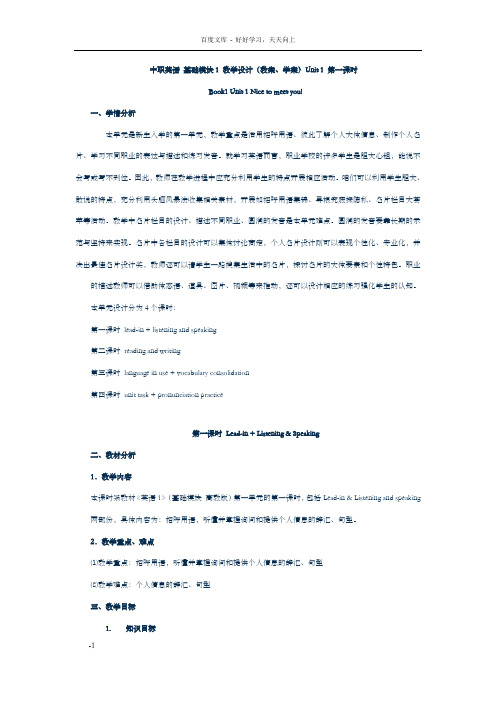
中职英语基础模块1 教学设计(教案、学案)Unit 1 第一课时Book1 Unit 1 Nice to meet you!一、学情分析本单元是新生入学的第一单元,教学重点是活用招呼用语、彼此了解个人大体信息、制作个人名片、学习不同职业的表达与描述和练习发音。
就学习英语而言,职业学校的许多学生是胆大心粗,能说不会写或写不到位。
因此,教师在教学进程中应充分利用学生的特点开展相应活动。
咱们可以利用学生胆大、敢说的特点,充分利用头脑风暴法收集相关素材,开展如招呼用语集锦、寻根究底探隐私、名片栏目大荟萃等活动。
教学中名片栏目的设计、描述不同职业、圆润的发音是本单元难点。
圆润的发音要靠长期的示范与坚持来实现。
名片中各栏目的设计可以集体讨论商定,个人名片设计则可以表现个性化、专业化,并决出最佳名片设计奖,教师还可以请学生一路搜集生活中的名片,探讨名片的大体要素和个性特色。
职业的描述教师可以借助体态语、道具、图片、视频等来推动,还可以设计相应的练习强化学生的认知。
本单元设计分为4个课时:第一课时lead-in + listening and speaking第二课时reading and writing第三课时language in use + vocabulary consolidation第四课时unit task + pronunciation practice第一课时Lead-in + Listening & Speaking二、教材分析1.教学内容本课时系教材《英语1》(基础模块高教版)第一单元的第一课时,包括Lead-in & Listening and speaking 两部份,具体内容为:招呼用语,听懂并掌握询问和提供个人信息的辞汇、句型。
2.教学重点、难点⑴教学重点:招呼用语,听懂并掌握询问和提供个人信息的辞汇、句型⑵教学难点:个人信息的辞汇、句型三、教学目标1.知识目标⑴掌握与个人信息相关的辞汇,如name, first name; last name; name card; telephone number; age; address; e-mail address; job (engineer; manager; secretary; teacher; student; doctor; nurse; singer; fans); position(boss);⑵掌握提供或询问个人信息时所利用的句型,如:1) about greeting:Good morning. Hi. Nice to meet you.2) about personal informationWhat’s you name? Where are you from? Which company are you from?2.能力目标⑴学生能听懂关于询问和提供个人信息的对话。
中职英语基础模块1 UNIT1Unit1(Lesson1)

Dialogue B
• 1. Read and underline(问候句)
• 2. repeat the sentences
3.Try to get more sentences(问候)
• Glad to meet you • Nice to meet you • Pleased to meet you • Good to see you
• How do you do ?
4. Practice : ABAB型对话
A: … B: … A: … B: …
Tang Hua
Example
A: Hi! I’m XXX. B: Hi! I’m XXX A: Nice(Glad) to meet you./ How do you do?/
How are you?/ How are things? B: Nice(Glad) to meet you, too./ How do you do?
Unit 1 New Friends
Lesson 1 Greeting
Hello, students! Welcome to our school!
1. The teacher Introduces herself
2. and then asks some students to introduce
Assessment and reflection
1. I can say_____,_______,______,… 2. If I meet Sara Smith,I can say______or
______ 3. If I want to get more information I can
say_____,_______,__________, 4. I can introduce my friend_______________.
中职英语基础模块unit第一课时[完美版]PPT
![中职英语基础模块unit第一课时[完美版]PPT](https://img.taocdn.com/s3/m/606ff12805087632301212bb.png)
p16
• 3. 指导学生完成Warming up ②图片和人物 性格搭配的练习,学习和巩固词汇 sunny, cool, funny。
• 2. 请学生介绍他们在班上的好朋友。尽量 用形容词描述朋友的性格特点。
3. 游戏:Are you good friends?
• 请两位同学参加游戏。 • 1) 两位同学分别面对两块答题板,根据老师的提
问,一位同学写出自己的答案,另一位则根据自 己对朋友的了解写出朋友会回答的答案;如: What’s your/his favorite food? What’s your/his favorite sport? • 2) 展示两位同学的答案; • 3) 教师请学生说出现在认识本班朋友的个数,单 元学习结束时进行比较。
小组学生打开所捡到的纸张,按照上面的 1) 两位同学分别面对两块答题板,根据老师的提问,一位同学写出自己的答案,另一位则根据自己对朋友的了解写出朋友会回答的答
案;
信息讨论所描述的是哪位同学,如A1是张 3)教师板书句型并讲解区别:
1) 教师使用PPT展示Listen and practice (p18)中图片,教师播放第一遍录音,提醒学生注意关于介绍人物的问题; 4)教师播放第二遍录音,学生打开书跟读。
中图片,教师播放第一遍录音,提醒学生注意关 于介绍人物的问题;
• 2)教师教读本单元单词middle, neighbor, kind, helpful.
(完整版)中职英语基础模块unit1
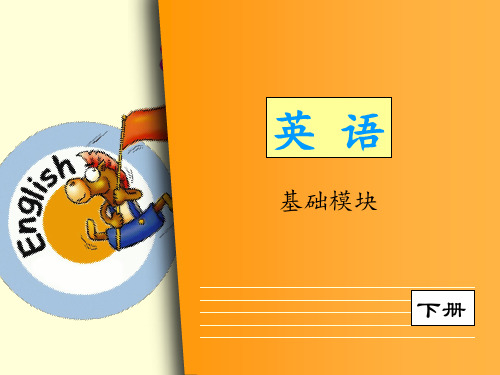
Section B Listening and Speaking
Warm-up
Dialo English Learning
Objectives
1. 能够辨别 /ɔː/ 和/aʊ/,/ɒ/和/əʊ/,/k/和/ɡ/,/j/和/dʒ/的 在句中发音的不同,并能正确掌握其发音。 2. 熟练掌握本单元出现的词汇、短语和句型,并能用 学过的短语、句型谈论英语学习。 3. 熟练掌握一般将来时态的用法。 4. 熟练掌握名片的基本写法。
Group 1 /ɔː/ and /aʊ/
Script (1)My uncle has a horse. (2)They shout at each other.
Group 2 /ɒ/and əʊ/
Script (1) That clock must be fast. (2) Tom wears a red coat today.
Warm-up Here are some sentences related to English learning. Please match them with the corresponding pictures.
5 Little Tom can’t remember new words he has learnt.
Activities
Warm-up Here are some sentences related to English learning. Please match them with the corresponding pictures.
外研社中职英语基础模块一 unit1第一次课

衷心感谢您的观看
参考译文
In what way? 是In what way is it different? 的省略形式。在口语 中,常会用到一些省略形式。
李伟:你知道吗,我的学校与众不同。 索菲: 真的吗?在哪方面呢? 李伟:我们在工厂里上技能训练课。 索菲: 你们通常都在那里做什么呢? 李伟:我们学习如何使用机器。 索菲: 那很有趣。
Listen and practice. 听录音,谈论校园生活。
Li Wei: You know, my school is quite different. Sophie: Really? In what way? Li Wei: We have our skill-training classes in a factory. Sophie: What do you usually do there? Li Wei: We learn how to use the machines. Sophie: That’s interesting.
Unit 1
School becomes interesting
Look at the picture and discuss:
1. Where are they? 2. What are they doing?
1 Listen and match. 听录音,将下列词语与图片匹配。
Key sentences:
classroom computer lab library factory dormitory
[ˈklɑːsrum] [kəmˈpjuːtə] [læ b] [ˈlaibrəri] [ˈfæktəri] [ˈdɔːmitri]
Look and tick 看图,选出你学过的课程。
高教社中职英语基础模块1unit课件

情境活动:设计各种情境活 动,让学生在活动中学习和
运用知识
情境评价:通过情境评价, 了解学生的学习情况和效果
任务驱动
任务驱动教学法: 以任务为驱动, 引导学生主动学 习
任务设计:设计 具有挑战性和趣 味性的任务,激 发学生的学习兴 趣
任务实施:引导 学生完成任务, 提高学生的实践 能力和创新能力
任务评价:对学 生完成任务的过 程和结果进行评 价,促进学生自 我反思和自我提 升
感谢您的观看
汇报人:
教师评价与反馈
评价标准:根据学生的学习表现、 作业完成情况、课堂参与度等方面 进行评价
反馈方式:及时向学生反馈评价结 果,指出优点和不足,提出改进建 议
添加标题
添加标题
添加标题
添加标题
评价方式:采用多种评价方式,如 教师评价、学生自评、同伴互评等
反馈内容:包括学习态度、学习方 法、学习效果等方面的反馈,帮助 学生了解自己的学习情况,提高学 习效果。
教学演示:教师示范讲解,帮助学 生掌握技能
添加标题
添加标题
添加标题
添加标题
教学动画:生动有趣的动画,帮助 学生理解知识点
教学案例:真实案例,帮助学生理 解知识点在实际中的应用
拓展资源
教材配套网站:提 供在线学习资源和 教学辅助工具
网络课程:提供在 线课程和视频教程, 方便学生自主学习
教学软件:提供英 语学习软件,如单 词记忆、听力训练 等
适用人群
中等职业学校学生
英语基础薄弱的学生
希望提高英语水平的学生
英语教师和教学研究人员
课件特点
内容丰富:涵盖中 职英语基础模块1 的所有知识点
形式多样:包括视 频、音频、图片、 文字等多种形式
中职英语基础模块1 UNIT1教案3
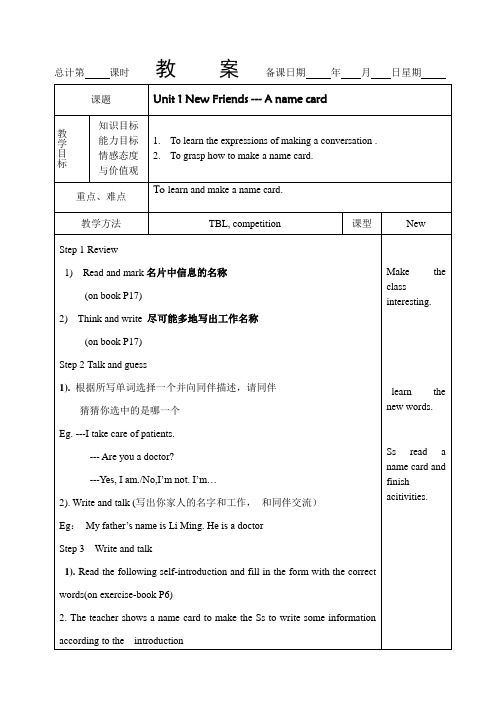
1.Make a name card for one of your family members
2.Write ashort passage to introduce itto the class
Step 5Homework
1.words practice(on exercise-book P1-2)
重点、难点
Tolearn andmake a name card.
教学方法
TBL, competition
课型
New
Step 1 Review
1) Read and mark名片中信息的名称
(on book P17)
2) Think and write尽可能多地写出工作名称
(on book P17)
2. The teacher shows a name card to make the Ss to write some information according to the introduction
His name is _____. He is 26 years old. He works _________. He likes reading and running. The hospital address is ______. His phone number is________. His e-mail address is____________.
Make a name card.
反思
授课日期年月日
2.Reading practice (on exercise-book P7)
3.Design a name card for yourself
Greetings中职英语基础模块 上册Unit 1课件1语文版

Phrases
family name 姓 given name 名 by the way 顺便说下 talk with 与……交谈
Notes
1. May I have your name,please? 请问你叫什么名字? 这是比较客气的询问别人姓名的一种说法。 类似的句子还有 What's your name, please? 例如: May I have your name,please? 请问你叫什么名字? My name is Gina. 我叫吉娜。 2. My family name is Smith and my given name is Jane. 我姓史密斯 名字是简。 family name 姓,given name 名。英语的姓名里通常由given name (名) ,middle name (中间名) ,family name (姓) ,一般结构为: 名+自取名+姓,但在很多场合中间名往往略去不写,如 George Water Bush一般写成 George Bush。上述名和中间名又称 个人名。
Activities
1 Work Alone 2 Pair Work 3 Group Work
Work Alone
Listen to the dialogue, and decide whether the following statements are true (T) or false (F). ( ) 1. Bruce and Jane meet for the first time. ( ) 2. Bruce majors in art. ( ) 3. Jane's QQ number is 245069.
2. What ways of greeting in other countries do you know?
中职英语(基础模块)教案
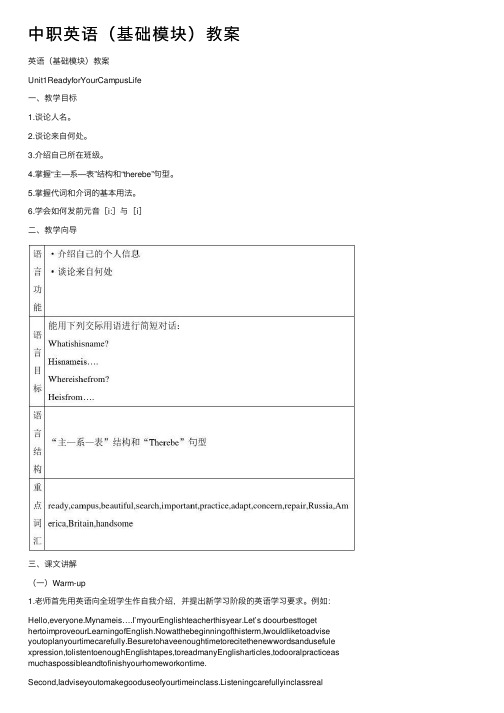
中职英语(基础模块)教案英语(基础模块)教案Unit1ReadyforYourCampusLife⼀、教学⽬标1.谈论⼈名。
2.谈论来⾃何处。
3.介绍⾃⼰所在班级。
4.掌握“主—系—表”结构和“therebe”句型。
5.掌握代词和介词的基本⽤法。
6.学会如何发前元⾳[i:]与[i]⼆、教学向导三、课⽂讲解(⼀)Warm-up1.⽼师⾸先⽤英语向全班学⽣作⾃我介绍,并提出新学习阶段的英语学习要求。
例如:Hello,everyone.Mynameis….I’myourEnglishteacherthisyear.Let’s doourbesttoget hertoimproveourLearningofEnglish.Nowatthebeginningofthisterm,Iwouldliketoadvise youtoplanyourtimecarefully.Besuretohaveenoughtimetorecitethenewwordsandusefule xpression,tolistentoenoughEnglishtapes,toreadmanyEnglisharticles,todooralpracticeas muchaspossibleandtofinishyourhomeworkontime.Second,Iadviseyoutomakegooduseofyourtimeinclass.Listeningcarefullyinclassreallymeanslessworklater.Takingnoteswillhelptoremindyouwhattheteachersaid. AnotherimportantsuggestionisthatyoushoulddevelopagoodattitudetowardsyourEnglishreading,listening,speakingandwriting.Don’tbeafraidofmakingmistakeswhenyouarespeakingEnglish.JusttryyourbesttosaywhatyouwantinEnglisheverytime.I’lldomybesttohelpyouandIhopeeveryonewillgetagreatprogressintheshortestpossib letime….此外,还可以设计⼀些常⽤⼝令、⼿势、规定⼀些纪律,以便在以后的教学中,形成良好的习惯,达成默契。
职高英语基础模块上Unit1课件
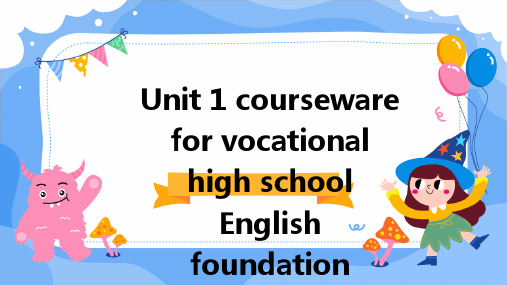
Listening exercises and answer analysis
Exercises should be designed to test students' comprehension of the listening materials rather than their ability to repeat words or phrases.
Students should be taught how to understand different speaking rates and volumes, as well as the use of pauses, emphasis, and intonation.
Students should be taught how to identify different types of English language registers, such as formal and informal language.
• Giving advice and suggestions: This topic helps students learn to give advice and suggestions on various topics, such as healthy living, travel, and study skills. They also learn to use modal verbs, such as "should" and "could," appropriately.
Analysis of Reading Skills
识别并分析文章结构
引导学生识别文章的主题句、段落大 意和整体结构,帮助学生理解文章的 主旨和逻辑关系。
中职英语1(基础模块)unit1 PPT

Where are you from? 你是哪儿人? e.g. — Where are you from? 你是哪儿人? — I’m from Beijing. 我是北京人。 — Where is he from? 他是哪儿人?
Tel: 022-84212663
E-mail: sarasmith@ Fucheng Vocational School Gao Bin Teacher Address: No. 28 Fucheng Street, Beijing Tel: 010-68253300 E-mail: gaobin0819@
Activity 15
No. 28 Furong Street, gaobin0819@sohu. 0731-85330011 com Changsha,Hunan
No. 37 Huayuan Street, Beijing lwz0701@ 010-88514618
Nice to meet you. 意为“见到你很高兴。” meet 在这里意为“见到,遇到”。 e.g. meet a friend 遇见一个朋友 We often meet some difficulties in our life. 在生活中我们经常会遇到一些困难。
Nice to meet you, too. 意为“见到你我也很高兴”。 nice 在这里意为“好,不错”。 e.g. It’s a nice party. 这是个不错的晚会。 That’s a nice picture. 那是幅很好的画。
- 1、下载文档前请自行甄别文档内容的完整性,平台不提供额外的编辑、内容补充、找答案等附加服务。
- 2、"仅部分预览"的文档,不可在线预览部分如存在完整性等问题,可反馈申请退款(可完整预览的文档不适用该条件!)。
- 3、如文档侵犯您的权益,请联系客服反馈,我们会尽快为您处理(人工客服工作时间:9:00-18:30)。
• 1. 师生Greeting互动。 • 2. 学生展示作业: •
1. 听前热身 教师请学生完成表格:
2. 词汇•
3. 播放听力(第一遍) What subjects can you hear? 4. 播放听力(第二遍) What subjects does Li Wei like? 5. 朗读课文 Read the passage by yourself first. Then, let’s read it together.
• Summary: What did we learn today?
• Homework • 1. Practice the dialogue with your partner. • 2. Ask five students from your class about the subjects(basic subject, skill-training class) they like.
4). Where do we have these classes?
• 2. All these classes below are called subjects. The classes in labs are called skill training classes. •
Listen and match
Listening and Speaking
3
Listen again and practice.再听录音,根据提示表演对话。
S1: You know, my school is quite different. S2: Really? In what way? S1: We have our skill-training classes in a factory. S2: What do you usually do there? S1: We learn how to use the machines.
6. 播放听力(第三遍),完成表格
1. 词汇学习 Match the words with the pictures.
2. 阅读① Read and fill in the form.
3. 阅读② • Read and fill in the form.
4. 播放听力
• 教师要求学生根据阅读②中的表格有针对 性地倾听,抓取重要信息。录音播放两遍, 第一遍后要求学生汇报所听到信息的数量; 听第二遍时要求学生一听到关键信息就示 意老师暂停。 • 1) How many pieces of information can you get? • 2) Raise your hand if you get key information. • 教师要求学生用there be 句型回答问题。
• 1. Remember what you hear in the dialogue. Any words, phrases, or sentences are ok. • 2. Listen again and get more information.
• 3. Discuss with your group members and fill in the blanks with your own words. Then show the dialogue to the class.
• How many basic subjects have we • learnt today? • How many skill-training classes have we learnt today? • 1. Read the passages again. • 2. Write down: all the majors and jobs in today’s class.
S2: That’s interesting.
1. 看图说话
• 1) Where do they have skill-training class? • 2) What do they learn there? •
2. 模拟对话
• 教师要求学生选取上述环节中的信息模拟 对话。
3. 自主对话
• 教师要求学生使用以下两个句型围绕校园 生活自主对话。
Unit 1 School becomes interesting.
LEAD-IN
• 1. ANSWER THE FOLLOWING QUESTIONS. • 1) What class did you have today? • Logistics Management(物流管理), Chinese, maths • 2) What class will you have tomorrow? • Computer basics(计算机基础), Chinese • 3) what other classes do you have? • Marketing(市场营销), Photoshop, maths(数 学), English, PE(体育课), etc.
